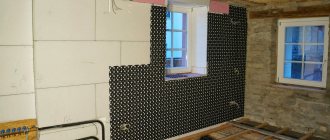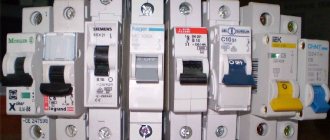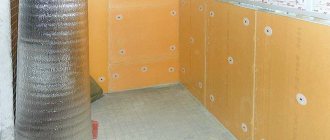Today we can no longer imagine our life without a large number of electrical appliances. They have penetrated every corner and become an integral part of daily activities. That is why high-quality laying and fastening of wires has become a pressing problem not only for production sites and office premises, but also for residential premises.
There are two types of fastening: open and hidden type. Next, we will consider each option in detail and find the optimal solution for all possible situations.
Fastening exposed wiring
In wooden buildings without additional interior finishing, wires are laid openly. You have to do the same in cases where no repairs are expected, but you need to install an additional socket or lamp. If it is not possible to run the cable through the baseboard, use cable ducts, insulators or plastic staples with nails.
- Cable channels are 2-meter plastic boxes of different sections with snap-on lids. The box is attached to the surface with self-tapping screws screwed into the inner surface of the rear wall; conductors are placed in it and closed with a lid.
Products come in different colors, including wood patterns, which allows you not to disturb the aesthetics of the premises. Source cable.ru
Porcelain insulators allow you to attach the wire to the wall or ceiling, imitating the retro style in the interior. They are made in the form of small barrels with a through hole, through which they are fixed with nails or screws, and wires twisted into a twisted bundle are pulled between them.
Against the background of wooden walls, insulators look more organic than cable channels
Plastic brackets with a hole for a nail, which is usually included, are fixed to surfaces made of wood, plastic and other non-solid materials. With their help, single cables can also be attached to furniture, for example, to organize computer wires under the desktop. They are often used to run telephone or internet cables above baseboards.
Nail clips for exposed mounting Source www.elektrikaup.ee
The only tools you need for electrical installation on wooden and similar surfaces are a hammer or a screwdriver, which can easily be replaced with a regular screwdriver.
General rules
When installing cables hidden or open, indoors or outdoors, there are several general rules:
- The optimal distance between fasteners is 40-50 cm.
- If self-tapping screws, screws, or dowels are used, they are tightened all the way so that the protruding cap does not damage the insulation.
- The cable is laid evenly, without humps. If a reserve is needed, it is placed in the least visible place.
It is advisable to lay the cable in a straight line - vertically or horizontally
Basically, that's all the recommendations. They are versatile and uncomplicated. The distance can be reduced if necessary. For example, at turns of the route, the fasteners are installed at a short distance from the bend point - 5-10 cm. The task is to ensure reliable fixation and prevent sagging.
Fastening hidden wiring
The cable fasteners described below can also be used for installing open wiring in rooms with increased fire safety requirements. For example, in a garage or in a bathhouse. But more often it is used for fixing wires on surfaces that are subsequently planned to be covered with a layer of plaster or decorative finishing - suspended or stretch ceilings, plasterboard, wall panels on a frame, etc.
For plaster, grooves are cut out for wires, but for suspended structures they are not needed Source avatars.mds.yandex.net
For reference! When laying the cable in a groove, you can secure it with gypsum or alabaster mortar. But for large-scale work this method is inconvenient, since such solutions harden very quickly and have to be mixed often in small portions.
Most often, during electrical installation work, you have to deal with surfaces made of various types of concrete and brick, into which nails and screws cannot be driven. Therefore, they select a different fastening for the wires, and as a tool they use a hammer drill for installing dowels or a mounting gun with special nails and fixing elements.
Using a hammer drill
Almost all fasteners for wires and cables are designed for fastening with dowels with a diameter of 6 mm. Therefore, you need to have a corresponding drill for the hammer drill for making holes in brick or concrete.
It is better to drill walls made of foam and aerated concrete with a conventional drill Source bitu.ru
See also: Catalog of low-cost house projects
Installation is carried out using the following elements:
- dowel-clamp - a plastic loop with legs that have spikes on the sides. Depending on the size and shape of the loop, a round or flat cable can be placed in it. To do this, it is pulled through the head of the loop, and the legs folded together are hammered into a hole drilled with a hammer drill. The angled spikes rest against the walls of the hole and securely hold the fastener in it;
Dowel clamp for round cable Source keltos.ru
- nylon cable ties with a dowel hole are a simple and cheap fastening for wires. After drilling a hole in the wall or ceiling, hammer a dowel into it and secure the screed with a self-tapping screw. Or, if the base is wooden, install it immediately with a self-tapping screw. Then the wire or bundle of wires is tied to the base, tightening the tie. The big disadvantage of this method is the impossibility of altering or dismantling the wiring without breaking the tie, since it can only be tightened once;
Cable tie for a screw Source www.officemag.ru
A dowel for a nylon tie is a plastic product with a thread or spikes on the leg and a large head with a flat through slot into which a regular tie is threaded after driving the dowel into the hole;
Dowel holder for screed Source kilovolt.by
See also: Catalog of companies that specialize in electrical work
- The dowel tie is a whole device assembled from a tie clamp, a plastic dowel consisting of two halves, and a fixing peg. Therefore, you won’t have to buy additional clamps for this fastener, they are already there. During installation, the two halves of the dowel are folded together and locked with a latch located at the ends, forming a leg with spikes. It is inserted into the hole and secured by driving a spacer peg into the dowel. Only the tie itself remains on the surface, which is used to tie up the cables;
Universal dowel-screed Source avatars.mds.yandex.net
- Square or rectangular mounting pads are flat plastic products with a mounting hole and “ears” or slots into which the tie is threaded. As in previous examples, first a 6 mm hole is drilled in the base into which a plastic dowel is inserted. Then the platform is secured to it with a self-tapping screw. There are pads without a mounting hole, but with a sticky layer on the back side, covered with a protective film. They stick to any smooth surface - furniture walls, plastic, tiles. After installing the platform, a nylon tie is threaded through the slot and the cable is secured to the wall or other surface. Moreover, several wires can be fixed simultaneously on one site.
Note! Nylon zip ties are an indispensable consumable for electrical installation work. They are used not only together with the listed fasteners, but also separately, for fastening cables to pipes or already laid electric mains.
How to attach a cable duct to a wall without drilling
- Registration
- Entrance
- To the beginning of the forum
- Forum Rules
- Old design
- FAQ
- Search
- Users
- List of forums AUTOLADA.RU
- Coffee shop and smoking room
why did you let him in under the ceiling? I spent it under my baseboard.
It’s just that the hole from the landing to the apartment is under the ceiling, and it’s best to go through the room where the computer is located under the ceiling. In general, all this space is temporary (although there is nothing more permanent than temporary
why glue at all? or “peck”?
buy a pack of plastic “ears” (or whatever they are correctly called) and attach small nails to the wall. Before renovation, this option is IMHO the best.
buy a pack of plastic “ears” (or whatever they are correctly called) and attach small nails to the wall.
I tried these “ears” but I couldn’t get the nails into the wall. They don't hold on. And drill a hole for each nail and hammer in a hole. something is wrong.
Is there a kind of double-sided tape that can be wound on a reel like regular tape? I've only seen small double-sided plates.
Is there a kind of double-sided tape that can be wound on a reel like regular tape?
Of course I have. In any business there should be, in principle. in construction markets - 100%.
but it’s unlikely to hold the wire. Maybe he himself is not stuck to the wall. And if it sticks (depending on the wall covering), then you’ll have a hard time peeling it off.
I would suggest running the wire down the door frame on the "ears", then along the baseboard, then, if necessary, along the jamb and up.
Well, you give it. What about the cable channel? I think the whole wiring is like this - it’s fun to look at.
+1, if the recess is screwed to the wall, then you can use the same double-sided tape along the entire length, it will hold
Of course have! Cluegan! - heating gun and polypropylene rods. Our office floor is supported by it. From the plastic, if desired, it can then be peeled off without leaving a trace. It's not true from the wallpaper.
My double-sided tape doesn't hold anything on. Babies, you may not know that the most amazing glue is sold in perfume stores and is called nail glue. Almost the entire car (95gv) was holding up on it, I advised my stepfather once - and now it’s holding up for him.
But yeah, baby dolls can’t do this. we are brutal mushes.
Construction mixture
Used for hidden cable laying in wall and ceiling grooves. For this, gypsum mortar is often used. This type of installation has a special name - “freezing”. There is nothing complicated about this method. An alabaster mixture is made and the cable is tacked in the groove in places evenly spaced from each other. This should be done promptly, since the plaster sets quickly enough.
Plaster solution for fastening wiring
This “freezing” is well suited for installation of a single cable in a groove. But this method is also used as an additional fastening of several cables, to secure already installed brackets, dowels, clamps, etc. After all this, the groove channels are filled with plaster mortar.
If the laying volumes are large, frequent preparation of the solution and fixation of the cable significantly reduces the installation speed. But in many cases this is completely justified.
Homemade fasteners
It often happens that there are no suitable brackets, pads or clamps to secure the cable. All these elements can be made yourself. Of course, in terms of their design they will most likely be inferior to factory elements, but in some cases this is not so important. And if your hands grow from where they need to be, then the fasteners can be quite a worthy replacement for branded fasteners.
Homemade wire fastener
A wide variety of materials can be used to make installation elements. These can be single-core or double-core wires, plastic, galvanized sheet and much more. Here are some of the DIY options.
The advantages of such homemade fasteners are as follows:
Source
Tips for choosing
It is necessary to select types of wire fastening based on the load created by the weight of the cable bundle. It is important to prevent possible breakdowns or ruptures of elements over time, that is, it is better to play it safe and use a more powerful and reliable type of fastening than a weak and cheap one.
The dowels and screws for fastening must match each other and the diameter of the hole, otherwise the fastening may fall out and the self-tapping screw may not be screwed into the dowel.
Despite the apparent simplicity of attaching cables, before purchasing parts, it is worth thoroughly deciding on their choice and, if necessary, conducting a test test. This will save you money and ensure high quality work.
How to glue fallen tiles to the wall and floor
A tile on the wall has fallen off
Over time, any repair gradually loses its original luster and gradually becomes unusable. Depending on the type of cement mortar, this problem is typical for the tiles; they simply peel off over time due to the destruction of the surface adhesive layer of the back surface. Moreover, the problem of fallen tiles, although significant, can be restored.
For this, a number of adhesive compositions are used; you can also solve the problem radically by replacing the cement mortar in the right places. To glue loose tiles in the bathroom, you can use one of the following methods, including the one shown in the video.
Advice from experienced craftsmen
As a rule, when it comes to such a problem as fallen tiles on the wall and floor in the bathroom or kitchen, it is recommended to glue it with one of the available materials:
Floor tiles fell off
- glue;
- homemade adhesive solution from linoleum and acetone;
- silicone sealant;
- put on oil paint;
- bitumen or resin;
- casein mastic;
- cement paste;
- liquid nails.
Each of these methods for falling off tiles has its own advantages, but still refers to a kind of “ambulance”, that is, unprofessional methods.
Considering that this problem occurs in places of vibration - the floor, a plumbing hatch with a panel or a bathroom door, you need to ensure reliable fastening for long-term use. In this sense, it is worth commenting on the above list of funds.
Homemade glue from linoleum and acetone
A home remedy for quickly repairing tiles in the bathroom and kitchen, on the wall and floor is glue made from leftover linoleum. It is prepared by cutting pieces of the coating and pouring acetone over them. The oil fraction acts as a solvent, resulting in a high-strength polymer adhesive. As is known, polymers have excellent adhesive ability.
Linoleum and acetone glue
According to reviews, this product glues ceramic tiles and wood better than many compounds. However, the recipe given refers to old manufacturing methods. At that time, linoleum was made from nitrocellulose and resins, the result was an NC-type adhesive that could actually be used to glue different surfaces, including concrete and ceramics.
Nitrocellulose adhesive is commercially available and is used mainly for parquet, wood, yachting and furniture. You can also use it to glue tiles that have fallen off, but they are not designed for this purpose.
PVC glue, which is obtained from modern linoleum, is an analogue of industrial compounds recommended for rubber and plastics. At the same time, the well-known Moment also applies to polyurethane compositions and can be used for gluing tile ceramics back to concrete.
Liquid nails for fallen tiles
Liquid nails Axton
There are quite a lot of adhesive compositions under the general name liquid nails; there is a mounting adhesive called Moment that belongs to this type. This composition is not bad, but it temporarily holds the ceramics on the concrete base.
Over time, it will disappear anyway. Some craftsmen, instead of liquid nails, recommend giving preference to regular PVA, which ensures normal adhesion to the surface.
Cement paste and tile adhesive
Cement or mortar mixture is the most suitable way to repair tiles. Use leftover cement or cement mixture. You will need to beat off the base with a chisel, put new dough and use a homemade level to glue the ceramic tiles.
As part of a budget renovation, this is one of the most affordable and reliable options. Moreover, in order to glue a fallen tile to the wall, if it has fallen off, it is better to use good tile adhesive rather than cement mortar. After curing, you will need to caulk the seams.
Modern adhesives for bathroom and kitchen tiles
Applying adhesive to tiles
These compositions for gluing tiles if they have fallen off are often used when installing a hidden plumbing hatch, but in this case the ceramics are placed on a wooden base, gluing with almost any available composition. For gluing to concrete, silicate glue is used, having previously treated it with silicate to improve adhesion. The result is a strong connection, but if you have loose ceramic tiles in an area of use, for example, near a door, then such repairs are only temporary.
Another affordable and reliable option is styrofoam glue. This is a mastic that has good binding ability to concrete. Perfect for the floor if you don’t want to use a radical method of repairing the wall with tile adhesive.











